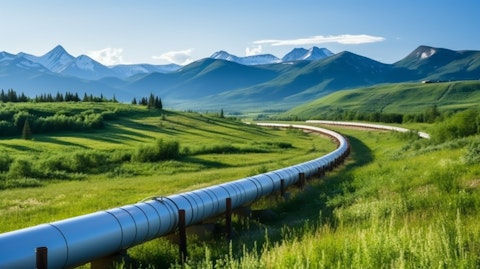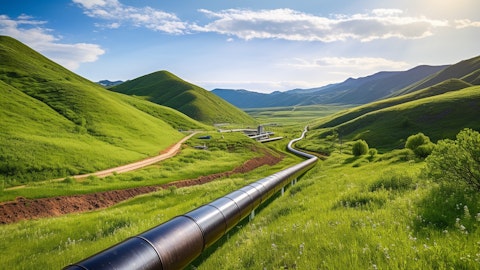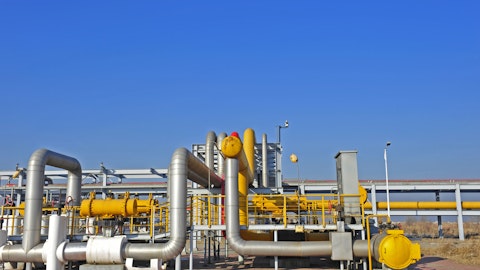Equitrans Midstream Corporation (NYSE:ETRN) Q4 2023 Earnings Call Transcript February 20, 2024
Equitrans Midstream Corporation beats earnings expectations. Reported EPS is $0.32, expectations were $0.18. ETRN isn’t one of the 30 most popular stocks among hedge funds at the end of the third quarter (see the details here).
Operator: Good morning, and welcome to Equitrans Midstream Corporation’s Fourth Quarter 2023 Earnings Call. All participants are in a listen-only mode. After the speaker’s presentation, we will conduct a question-and-answer session. [Operator Instructions] As a reminder, this conference call is being recorded. I would now like to turn the call over to Anthony DeFabio, Treasurer and Director, Investor Relations. Thank you. Please go ahead.
Anthony DeFabio: Good morning, and welcome to the Fourth Quarter 2023 Earnings Call for Equitrans Midstream Corporation. A replay of this call will be available for 14 days beginning this evening. The phone number for the replay is 800-770-2030 or 647-362-9199. The conference id is 6625542. Today’s call may contain forward-looking statements related to future events and expectations. Please refer to today’s news release and risk factors in ETRN’s Form 10-K for the year ended December 31, 2022, and as updated by Form 10-Qs for factors that could cause the actual results to differ materially from these forward-looking statements. Also, the form 10-K for the year ended December 31, 2023, is expected to be filed with the SEC later today.
Today’s call may contain certain non-GAAP financial measures. Please refer to this morning’s news release and our investor presentation for important disclosures regarding such measures, including reconciliations to the most comparable GAAP financial measure. On the call today are Diana Charletta, President and CEO; Kirk Oliver, Executive Vice President and Chief Financial Officer; Justin Macken, Executive Vice President – Pipeline Operations and Project Execution; Nate Tetlow, Senior Vice President, Commercial Services; Janice Brenner, Senior Vice President, Finance and Investor Relations; and Brian Pietrandrea; Vice President and Chief Accounting Officer. After the prepared remarks, we will open the call to questions. With that, I’ll turn it over to Diana.
Diana Charletta: Thanks, Anthony, and good morning everyone. As many of you know, effective January 1, Tom Karam moved into the role of Executive Chairman. Tom has led Equitrans for the past five years since we started as a standalone company. We want to thank him for his unwavering efforts and continued support. Before we jump into the business discussion, I want to address a statement from this morning’s news release. Our Board has been engaged in a process with third parties that have expressed interest in strategic transactions with us. We are not surprised by this interest, given the expected near-term completion of MVP and our view of the strength of our asset. Our Board has engaged the outside advisor and the process is ongoing.
As you may expect, we will not be addressing questions on this matter. Moving on to the business update, our priority remains bringing MVP into service safely, which includes a steadfast focus on the project’s environmental protocols and maintaining permitting compliance. This morning, we updated our targeted completion to the second quarter of 2024 at a total estimated project cost ranging from approximately $7.57 billion to approximately $7.63 billion. Following the passing of the Fiscal Responsibility Act of 2023, we have made substantial construction progress. As we exited 2023, we continued to track to our prior guidance despite challenging construction conditions which caused lower productivity than we forecasted. In addition to unforeseen construction issues, throughout much of January, we encountered considerably adverse weather conditions, including precipitation well above 20-year averages.
While our construction plans took into account the potential effects of winter weather, these conditions were far worse and lasted much longer than anticipated, which had a significant impact on productivity, which in turn impacted our ability to reduce construction headcount. These factors resulted in our updated timing and total project cost targets. More recently, the weather has been favorable and our productivity rates have shown improvement. As of February 15, roughly 300 miles of pipe had been installed, leaving less than 4 miles remaining. Of the 428 water crossings that remained when construction resumed in 2023, we had 13 left to cross. We are purged and packed through the first 77 miles of the project and hydro-tested just about 180 miles and progress continues every day.
If the current weather conditions continue, by the time we exit February, we expect to have further narrowed the list of overall construction time. And the remaining construction is expected to be limited to three of the project sign working spread, all in Virginia. The construction work in these areas will consist of finishing the remaining crossings of which fiberboard completing the Appalachian Trail crossing, and installing pipe on some of the steepest slopes along the route. Once construction is complete, only commissioning activities will remain before we place the pipe in service, which are less impacted by weather and require far less labor. While the majority of MVP construction is complete, the remaining construction includes some of the most difficult tasks on the project and could present further challenges.
We are narrowing the scope of remaining activities and our focus remains to safely bring this critical pipeline into service. I’ll now turn it over to Justin for the operations update and then Kirk will discuss the financial results. Justin?
Justin Macken: Thanks, Diana. Good morning, everyone. Let’s start with our Gathering segment. In 2023, we averaged about 7.7 Bcf per day of gathered volumes, which was roughly flat year-over-year. For 2024, we expect gathered volumes to again be flat on a year-over-year basis as we continue to see producers remain at maintenance levels. Our Hammerhead asset continued to provide interruptible service in the fourth quarter and we will be ready to reverse flow and make deliveries to MVP when Hammerhead achieves full commercial in service alongside MVP in service and firm commitments commence. In 2023, we also made progress on a compression project for a producer customer who installed 32,000 horsepower of booster compression that is backed by a long-term firm commitment and is expected to be in service in the coming days.

The majority of capital investment for this project was in 2023. Our gathering and transmission systems are highly integrated and currently provide the only direct upstream connectivity to MVP. MVP and the potential expansion project would add approximately 2.5 Bcf per day of takeaway capacity to an area of the basin that has been constrained for several years. Given this dynamic, combined with the growing demand in the southeast and expected improvements to TETCO M2 pricing with MVP in service. We believe that over the next several years there is a path for volume growth within the basin, following MVP in service. Today, we initiated 2024 gathering CapEx guidance of $210 million to $260 million. Moving on to transmission, we are nearing completion of the Ohio Valley Connector Expansion Project, or OVCX, which we expect to place in service in the second quarter of 2024.
OVCX will add about 350 million cubic feet per day of incremental capacity. Once the expansion is complete, our OVC pipeline will have the ability to move over 1.2 billion cubic feet per day of gas to Clarington, Ohio, and can also provide backhaul capacity to reach MVP with the same capacity, enhancing base and liquidity and providing customers significant optionality. Our 2024 transmission CapEx guidance is $75 million to $85 million, which includes approximately $40 million for the OVCX project. In December, the MVP joint venture executed 20-year binding precedent agreements with two Southeast utility customers for the amended Southgate project. In aggregate, the firm capacity commitments total 550 million cubic feet per day. The joint venture recently completed an open season and expects to finalize the project scope in the coming months.
Currently, the Southgate project is targeted to be completed in June 2028. On the Water segment, in 2023 we completed the majority of our mixed-use water system. For 2024, our water CapEx is expected to be approximately $25 million to $35 million. I’ll now turn the call over to Kirk.
Kirk Oliver: Thanks, Justin, and good morning everyone. This morning we reported full-year net income attributable to ETRN common shareholders of approximately $387 million in earnings per diluted common share of $0.89. Net income for the year was $455 million, adjusted EBITDA was $1,056 million and deferred revenue was $329 million. We also reported full-year net cash provided by operating activities of approximately $1 billion and free cash flow of negative $129 million. For the fourth quarter, we reported net income attributable to ETRN common shareholders of $134 million, and earnings per diluted common share of $0.31. Net income was $150 million, adjusted EBITDA was $272 million and deferred revenue was $88 million. We also reported net cash provided by operating activities of $291 million and free cash flow of negative $241 million.
Net income attributable to E-Train common shareholders for the full year was impacted by several items. First, by $9.4 million of operating expense related to the Rager Mountain storage incident; second, a $7.8 million write-down of a contract asset in the Water segment; and last, a $1.5 million unrealized gain on derivative instruments, which is reported within other income. This relates to the contractual provision entitling E-Train received cash payments from EQT conditioned on specific NYMEX Henry Hub natural gas prices exceeding certain thresholds, post MVPs in service, and through 2024. After adjusting for these items, full-year adjusted net income attributable to ETRN common shareholders was $398 million, and adjusted earnings per diluted ETRN common share was $0.91.
The fourth quarter was impacted primarily by a $5.9 million unrealized loss on derivative instruments related to the contractual provision with EQT mentioned earlier. After adjusting for this Q4 adjusted net income attributable to ETRN common shareholders was $139 million and adjusted earnings per diluted share was $0.32. Additionally, we reported full-year equity income of $175 million and fourth quarter equity income of $78 million, which is primarily associated with AFUDC relating to MVP construction. Operating revenue for the full year increased by $36 million compared to last year, which was primarily driven by increased transmission and water service revenue and was partially offset by lower gathering revenue. Revenue for the fourth quarter of 2023 increased by $5.4 million compared to the fourth quarter of 2022, primarily as a result of increased gathered volumes partially offset by lower water volumes.
Operating expenses for the full year increased by approximately $89 million compared to 2022 due to increased SG&A and O&M cost, primarily due to an increase in personnel cost related to the MVP performance award and other incentive compensation, as well as an increase of water expenses, including the $7.8 million contract asset writedown and increased appreciation expense. Operating expenses for the fourth quarter of 2023 were roughly flat compared to the same quarter for 2022. For the fourth quarter of 2023, ETRN paid a cash dividend of $0.15 per common share on February 14, 2024, to shareholders of record at the close of business on February 6, 2024. Finally, today we initiated guidance for 2024. For the full year, we’re forecasting net income of $375 million to $455 million.
Adjusted EBITDA of $1.235 — $1.315 billion and deferred revenue of approximately $145 million. We’re also forecasting full-year CapEx and capital contributions of $850 million to $955 million. Free cash flow of negative $65 million to negative $145 million and retain free cash flow of negative $325 million to negative $405 million. I’ll now hand the call back to Diana.
Diana Charletta: Thanks, Kirk. Before we open the call to questions, I would like to take a minute to thank our employees. They remain endlessly committed to ETRN success, through their ongoing commitment to safety and environmental compliance. Thank you. And with that, we’ll open the call to questions.
Operator: [Operator Instructions] Our first question comes from Spiro Dounis from Citi. Please go ahead. Your line is open.
See also 30 Best Places to Visit in the US in the Spring and The World’s 16 Most Expensive Private Islands to Visit.
Q&A Session
Follow Midstream Co Llc (NYSE:ETRN)
Follow Midstream Co Llc (NYSE:ETRN)
Receive real-time insider trading and news alerts
Spiro Dounis: Thanks, operator. Good morning, everybody. Would of course have loved to have started with the strategic process, but it sounds like that’s out of bounds today. So maybe start with the MVP expansion, the opportunity there, and thinking about it incorporate some value. Just curious if you all could speak to maybe some of the returns you’d expect from a project like that. I believe it’s just compression and not to get too ahead of it, but is it expandable beyond a 0.5 Bcf a day, if you do looping and compression as well?
Justin Macken: Hi. This is Justin. So I guess, starting with the scope, we expect the expansion will probably be in the range of 0.5 Bcf a day, as we’ve talked about previously. Based on where we have scoped out the fourth greenfield compressor station and what we are physically able to add at the other stations, that’s probably the sweet spot for expansion. Technically, there are ways to go above that, but we’ll have to weigh the economics of doing so. You know in terms of build multiples you’re probably looking in the 3 Bcf to 4 Bcf range because this is a very strong project, limited to just the compression investment.
Spiro Dounis: Got it. It’s a helpful color. And maybe turn back to MVP construction. Diana, I appreciate all the color on the process. From here it sounds like some of the more challenging routes are still ahead, but I kind of anticipated. I guess, with that range that you had mentioned, just look at some of the local news reports, it seems like there was some runoff issues and potentially some local complaints. Just want to make sure, can you just confirm all permits are still in good standing? The weather issues have not triggered, any sort of delays from an oversight perspective either.
Diana Charletta: Yes. So the permits are all still good. Working very closely with the Virginia DQ and the other agencies. The inspectors are out there daily and we’re actually — I think that issue has cleared up a bit as far as the turbidity and working with the landowner there, but everything is in good shape.
Spiro Dounis: Great. I’ll leave it there for today. Thanks for the time.
Diana Charletta: Thank you.
Operator: Our next question comes from John Mackay from Goldman Sachs. Please go ahead. Your line is open.
John Mackay: Thanks for the time. Maybe I’ll just pick up on that last point because it’s kind of the theme here. Just in terms of the new timeline, I think you’re pointing to a June 1 in-service, at least kind of baked into your guidance. Curious, just if you could frame that up, I mean, it’s two months kind of past your prior benchmark. You’ve probably seen a month of delays. So just trying to think of how conservative you’re feeling on that number right now and maybe any more guideposts to watch from here.
Diana Charletta: Sure. With every week of good weather, we’re able to narrow the variability of that cost, and that timing. Challenges obviously still remain, but they’re decreasing with — as we complete each task. February weather has been better. We did have some rain, I think the weekend before last, but the next 10 days look pretty good and that’ll get us to the end of the month. So productivity has improved since January. Daylight continues to increase, which lengthens our workday. We have a handful of bores left to complete and some steeps, but the work plan for April is substantially commissioning work, which will require significantly less people and will not be as sensitive to weather. So that’s kind of how I look at it. We will finish up construction through March, and April will mostly be commissioning.
John Mackay: Just to clarify that, I think in the past you’ve talked about commissioning generally being about a month. Is that fair?
Diana Charletta: Yeah, that’s our activities. We’ve been commissioning on the pipeline. 77 miles already have gas in them, and it’s purged impact. But we still have our third compressor station, and we need to get gas to it, which will happen sometime in March. And then after we complete these other couple of pieces, we’ll hydro-test and work as we go. So about a month is a good rule of thumb.
John Mackay: Thanks for that. Maybe just second question here. Thanks for that clarification. You got some incremental leverage relief, I think, on your revolver. Maybe, Kirk, I guess this is for you. Maybe just frame that up in the context of the increased CapEx cost and how you’re feeling about your buffer versus these new ceilings? Thanks.
Kirk Oliver: Yeah, feeling really good about the buffer. So what we did is — and the banks have been really good to work with on this, but we got the leverage covenant raised to six times for Q1, 6.25 times for Q2, and then it comes back to 5.85 times, and then down to 5.5 times on the following quarters.
John Mackay: Alright. Thank you. Appreciate the time.
Operator: Our next question comes from Michael Blum from Wells Fargo. Please go ahead. Your line is open.
Michael Blum: Thanks. Good morning, everyone. Maybe we’ll stay on the balance sheet since that was the last question. Wanted to just kind of get your thoughts on the dividend at this point as a lever, given that, clearly, with all the CapEx spending, that leverage is higher. Any thoughts to reduce the dividend to free up some cash to accelerate the deleveraging process?
Kirk Oliver: No, we haven’t got any thoughts about doing anything with the dividend right now. We are focused on delevering, and we have the MVP project financing that we will be turning to as soon as MVP is in service. And that’ll be a big chunk of debt reduction right there. We’ve said, I think, $800 million to $1 billion on that, and we are looking at possibly increasing that amount, if we can in the markets there at the time.




